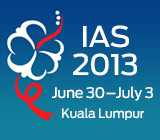 Preliminary results from a trial in which two HIV-positive people with lymphoma received stem cell transplants and then later stopped taking their antiretrovirals (ARVs) have shown that, as of now, neither of them has any sign of the virus, The New York Times reports. These findings were announced at the 7th annual International AIDS Society Conference in Kuala Lumpur. Researchers at Harvard Medical School and Brigham and Women’s Hospital in Boston treated three HIV-positive men for lymphoma, a blood cancer, with reduced-intensity chemotherapy followed by stem cell transplants.
Preliminary results from a trial in which two HIV-positive people with lymphoma received stem cell transplants and then later stopped taking their antiretrovirals (ARVs) have shown that, as of now, neither of them has any sign of the virus, The New York Times reports. These findings were announced at the 7th annual International AIDS Society Conference in Kuala Lumpur. Researchers at Harvard Medical School and Brigham and Women’s Hospital in Boston treated three HIV-positive men for lymphoma, a blood cancer, with reduced-intensity chemotherapy followed by stem cell transplants.
One of the men died of lymphoma. In the surviving pair, who received their transplants two and five years ago, respectively, even the most sensitive viral load tests have not been able to detect virus in their blood after the stem cell transplants. Nor have tests conducted on their rectal tissue, which is a major part of the HIV reservoir, been able to pick up signs of HIV. However, the investigators say they cannot be certain the virus is not still hiding in other parts of the reservoir, such as the brain.
One man has gone 15 weeks without a viral rebound since stopping ARV treatment, and the other has gone seven weeks with such success. About a year is required, though, before the researchers can predict with particular certainty that neither man will experience resurgent virus. Researchers in the HIV/AIDS field differ on how to categorize someone as “functionally cured,” or “cured,” but none are yet ready to label either man as such.
The first person considered functionally cured of HIV, Timothy Brown, a.k.a. “The Berlin Patient,” received a stem cell transplant to treat his leukemia from a donor who had a genetic abnormality called a CCR5 delta32 mutation that made him naturally resistant to the virus.
Neither of the patients in this new study received a transplant with such a mutation. Their cases also differ from Brown’s because the chemotherapy they received was less intense, allowing them to maintain some of their own immune cells as well as to remain on ARVs. While Brown’s physical condition remains challenged following his treatment, both men in this new trial are reportedly feeling very well.
The investigators theorize that a phenomenon known as graft-versus-host disease was the reason both men saw the apparent elimination of their HIV reservoirs. During this process, which lasts for about nine months after the transplant, the new immune cells attack the old ones, which have been weakened by chemotherapy and which in these cases were the only cells infected with the virus. Graft-versus-host disease can be fatal if left unchecked, so both men received intermittent rounds of immunosuppressive therapies and steroids. Sirolimus, an immunosuppressive drug, may also have helped eliminate HIV from their bodies.
The researchers stress, nevertheless, that the transplant these men received is not a feasible route to a cure for anyone who does not otherwise require one to treat cancer, as the procedures are highly risky and have a mortality rate of 15 to 20 percent.
“These findings clearly provide important new information that might well alter the current thinking about HIV and gene therapy,” said Kevin Robert Frost, CEO of amfAR, The Foundation for AIDS Research, which sponsored the research team over the past year in their effort to remove the men from ARVs. “While stem-cell transplantation is not a viable option for people with HIV on a broad scale because of its costs and complexity, these new cases could lead us to new approaches to treating, and ultimately even eradicating, HIV.”
To read the amfAR release, click here.
To read the Times report, click here.
Advertisement
Advertisement
Advertisement






3 Comments
3 Comments